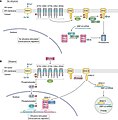ملف:Ethylene signaling pathway.jpg
المظهر

حجم هذه المعاينة: 591 × 599 بكسل. الأبعاد الأخرى: 237 × 240 بكسل | 473 × 480 بكسل | 757 × 768 بكسل | 1٬262 × 1٬280 بكسل.
الملف الأصلي (1٬262 × 1٬280 بكسل حجم الملف: 217 كيلوبايت، نوع MIME: image/jpeg)
تاريخ الملف
اضغط على زمن/تاريخ لرؤية الملف كما بدا في هذا الزمن.
| زمن/تاريخ | صورة مصغرة | الأبعاد | مستخدم | تعليق | |
|---|---|---|---|---|---|
| حالي | 12:06، 12 يونيو 2021 |  | 1٬262 × 1٬280 (217 كيلوبايت) | Chhandama | Uploaded a work by Brad M. Binder from Binder B. M. (2020). Ethylene signaling in plants. The Journal of biological chemistry, 295(22), 7710–7725. https://doi.org/10.1074/jbc.REV120.010854 with UploadWizard |
استخدام الملف
الصفحة التالية تستخدم هذا الملف:
الاستخدام العالمي للملف
الويكيات الأخرى التالية تستخدم هذا الملف:
- الاستخدام في de.wikipedia.org
- الاستخدام في en.wikipedia.org
